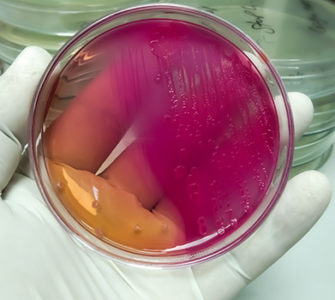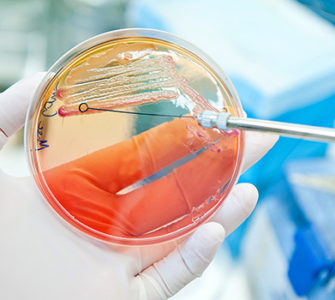Study shows value of E. coli vaccine in chickens
A live Escherichia coli vaccine provided a high level of protection to chickens challenged with the same E. coli strain as well as cross-protection against a different strain in a recent study conducted in the Netherlands.
The best protection was achieved when the live vaccine was administered along with an inactivated vaccine, said Harm Geerligs, PhD, associate director, veterinary medical research and development, poultry biologicals, Zoetis.
Producers who need to protect their chickens against E. coli infection routinely use inactivated autogenous vaccines produced from bacterial isolates on a farm, he explained, but in recent years more of them have been using the live vaccine Poulvac® E. coli. This commercial vaccine contains an 078 strain of E. coli, but Zoetis scientists deleted the strain’s aroA gene to prevent it from causing disease, he explained.
Vaccine efficacy
In the first part of their study, Geerligs and colleagues compared the efficacy of Poulvac E. coli to an inactivated autogenous 01 strain E. coli vaccine prepared from field cultures (Table 1). The live vaccine was administered by spray and the inactivated vaccine by intramuscular injection.
At 14 weeks of age, the researchers challenged vaccinated birds and unvaccinated controls with either a virulent 078 strain (homologous challenge) or a virulent 01 strain of E. coli (heterologous challenge).
The researchers then observed the chickens for 7 days and examined them for lesions characteristic of E. coli, such as airsacculitis, pericarditis, perihepatitis, peritonitis and splenomegaly.
After the 078 challenge, there was no mortality in the live-vaccine group, but mortality occurred in the inactivated group and unvaccinated controls (Table 1). After the 01 challenge, mortality occurred only among unvaccinated birds.
Lesion scores
Based on lesion scores, the researchers concluded that protection against 078 in birds that received the live vaccine was significantly better compared to the inactivated and unvaccinated groups (p < 0.05), Geerligs said.
Protection against the 01 challenge was comparable in the two vaccine groups and was significantly better compared to unvaccinated controls (p < 0.05), he said.
Table 1. Design of challenge study part 1 and results
| Day 1 of age | 12 weeks of age | Challenge at 14 weeks | Mortality | Protection level |
| Sterile water | Sterile water | E. coli 078 | 4/15 | 33% |
| Sterile water | Sterile water | E. coli 01 | 2/15 | 7% |
| Sterile water | Inactivated vaccine 01 | E. coli 078 | 1/15 | 40% |
| Sterile water | Inactivated vaccine 01 | E. coli 01 | 0/15 | 40% |
| Live E. coli | Live E. coli | E. coli 078 | 0/15 | 80% |
| Live E. coli | Live E. coli | E. coli 01 | 0/15 | 47% |
The second part of the study included both the live and inactivated vaccines in the same birds (Table 2); administration of the vaccines and follow-up were conducted the same way they were in the first part of the study.
Challenge with virulent E. coli 078 at 18 weeks of age caused no mortality in any of the groups. Use of the live or autogenous vaccine alone on day 1 and 12 weeks of age provided protection to the majority of birds.
The best protection was achieved when both vaccines were used, and it was significantly better compared to protection in unvaccinated controls (p < 0.05), Geerligs reported.
Table 2. Design of challenge study part 2 and results
| Age day 1 | Age 12 weeks | Age 16 weeks | Age 18 weeks | Mortality | Protection level |
| Live E. coli | Live E. coli | — | E. coli 078 | 0/15 | 73% |
| Live E. coli | Live E. coli | Inactivated vaccine 01 | E. coli 078 | 0/15 | 93% |
| Sterile water | Inactivated vaccine 01 | Inactivated vaccine 01 | E. coli 078 | 0/15 | 73% |
| Sterile water | Sterile water | — | E. coli 078 | 0/15 | 47% |
‘High level’ of protection
“We can conclude from this study that the live E. coli vaccine administered at day 1 and 12 weeks of age can provide a high level of protection toward homologous challenge for at least 18 weeks of age and cross-protection toward challenge with E. coli 01 at a level similar to protection with an autogenous vaccine,” he said.
“The study further suggests that using both a live and inactivated vaccine is beneficial for protecting chickens against E. coli infection,” Geerligs said.
Zoetis sponsored the study, which was conducted at the GD Animal Health Service in Deventer, the Netherlands.
Posted on March 30, 2016

















